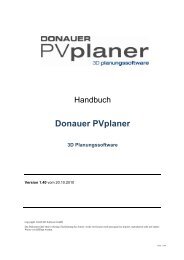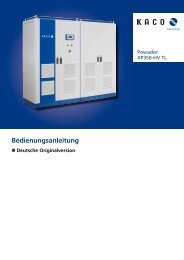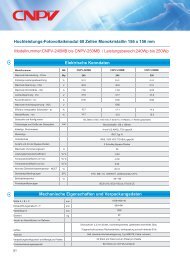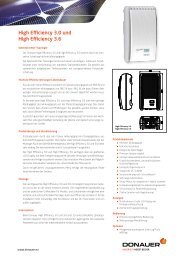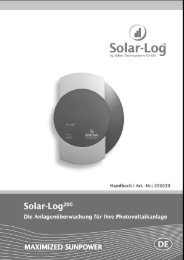SUNNY ISLAND 5048 - Technical Description - Wind & Sun Ltd.
SUNNY ISLAND 5048 - Technical Description - Wind & Sun Ltd.
SUNNY ISLAND 5048 - Technical Description - Wind & Sun Ltd.
You also want an ePaper? Increase the reach of your titles
YUMPU automatically turns print PDFs into web optimized ePapers that Google loves.
Battery Management SMA Solar Technology AG<br />
NOTICE!<br />
Possible damage to the battery as a result of faulty temperature measurement<br />
If the battery temperature sensor is defective or missing, the <strong>Sun</strong>ny Island continues to run,<br />
assuming the battery has a temperature of 40 °C. This can result in insufficient charging of<br />
the battery in the long run.<br />
• Observe the corresponding warnings of the <strong>Sun</strong>ny Island.<br />
• Connect the battery temperature sensor.<br />
• Replace the defective battery temperature sensor.<br />
13.2 Start Options<br />
If the battery is replaced in a plant, the battery management system must be restarted and<br />
reconfigured. This can be done using the "Quick Configuration Guide QCG" (see section<br />
8.2 ”Starting the Quick Configuration Guide (QCG)” (page 57)).<br />
13.3 State of Charge / SOC and SOH<br />
The <strong>Sun</strong>ny Island has a very precise internal state of charge calculation (display value<br />
"120.01 BatSoc"). The procedure for calculating the state of charge is based on balancing the<br />
ampere hours. This means that all currents flowing in and out of the battery are accumulated and<br />
referred to the nominal capacity. In order to take into consideration faults caused by self-discharge<br />
and charging losses caused by gassing, these losses are already internally extracted. Unlike other<br />
operations, no fixed charging factor must be set.<br />
When the full charge states are reached, the battery state of charge is reset to values of 90 %,<br />
95 % or 100 %, depending on how full battery was actually charged. If default settings are not<br />
changed, a state of charge of 80 % after boost charge, 95 % after full charge and 100 % after<br />
equalization charge is reached.<br />
Since full charge states are generally only rarely achieved during a grid failure, the operation used<br />
here can also utilize the battery voltage during constant discharge phases with low discharge currents<br />
to recalibrate the state of charge. Compared to the ampere-hour balancing method, the operation<br />
used here exhibits a high level of stability over the long term when recalibrated at regular intervals.<br />
Both the ampere-hour balancing method and the recalibration procedure, which is performed via the<br />
voltage, automatically adjust to the connected battery over time (depends on the number of grid<br />
failures).<br />
The estimated state of charge error (display value "120.11 BatSocErr") will provide you with<br />
continuous information on the accuracy of the battery state of charge currently calculated. The<br />
average error will continuously diminish as the adjustment to the actual battery state of charge<br />
increasingly improves.<br />
Only when the battery is new does its usable capacity correspond to the capacity specified by the<br />
battery manufacturer. As the battery ages and as a result of frequent insufficient charging, the battery's<br />
usable capacity may decrease considerably on a permanent or only temporary basis.<br />
98 SI<strong>5048</strong>-TB-TEN110340 <strong>Technical</strong> <strong>Description</strong>






